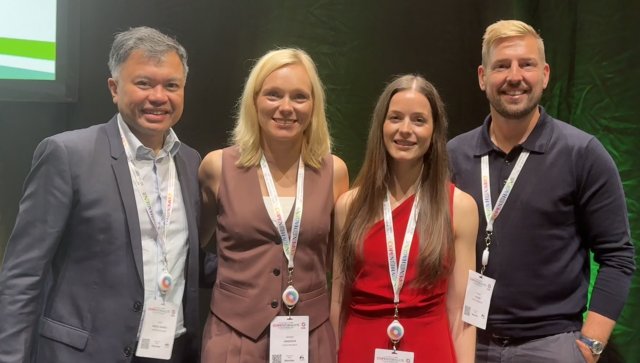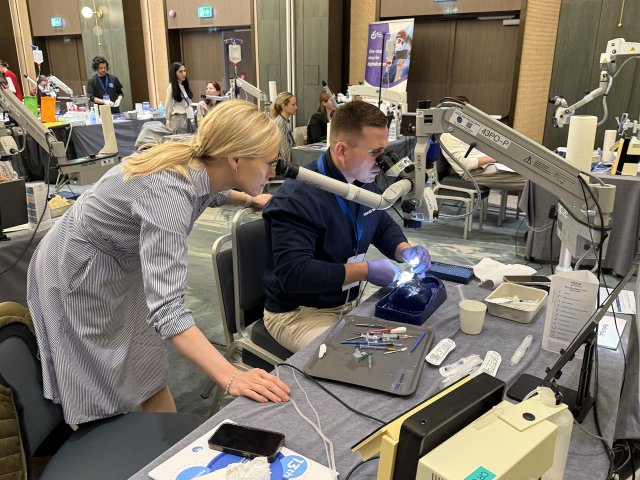“To present the topic of digitalization and artificial intelligence at one of the world’s largest events in the field of eye microsurgery is a huge recognition of our work,” says Andrea Janeková, Head Physician of the Cataract, Refractive and Vitreoretinal Surgery Centre at Eye Centre Prague (OCP). We spoke with her shortly after her return from the prestigious ESCRS (European Society of Cataract and Refractive Surgeons) Congress, held this year in Copenhagen, Denmark, with more than 15,000 members of the ophthalmological community from 137 countries in attendance. “Ophthalmology is a wonderful field. What fascinates me about it is that it is very technical and combines everyday patient care with the latest technologies. It is encouraging to confirm, at one of the world’s largest eye microsurgery events, that we really work with the very best at our clinic and that we can serve as an inspiration to our colleagues.”
Can you tell us what your lecture for the packed auditorium was about?
I wanted to use the example of many years of experience at OCP to show how significantly cutting-edge technologies can benefit our work. It’s alarming that one fifth of the doctors surveyed at the congress still think that digitalization will not bring them any benefits.
How did you make your case?
Simply put – new technologies allow us to work far more precisely and quickly, which also increases the comfort and safety of procedures. Digitalization of individual processes tracks the patient from their first visit through surgery and post-operative examinations within a single system. The information is available to all colleagues, which brings many benefits. Different systems can record individual steps during the operation, making it possible to evaluate, compare, share across facilities and continue learning from it.
At OCP, we are lucky to work with the best technologies currently available in our field. The progress has been dramatic. For example, not so long ago we had to mark the position of a patient's eye with a marker in the operating room before surgery while the patient was sitting up, because when a person lies down, the eye rotates slightly and the deviation must be corrected. Today, a device photographs the eye and is able to digitally project the necessary deviation directly onto it. Moreover, all measured data at OCP is now sent from the devices directly to the operating room via our data infrastructure, which completely eliminates potential errors – only a few years ago, the data was transcribed manually.
Compared to foreign clinics, is there anything that sets your workplace apart?
In terms of equipment, we keep up with the best clinics in both Western Europe and the US. But what is perhaps different here is that we mainly use digitalization of processes and gradually integrate AI into the care of all our patients. This direction is a great help and those who fail to embrace these trends will not move forward.
Digitalization was not the only topic you presented at the world congress.
My other lecture presented the results of testing a new trifocal lens from the German company Zeiss. OCP was one of four centres in the Czech Republic that participated in the study. We conducted a six-month trial on the largest group of patients and found that this lens perfectly meets the needs and preferences of modern eye microsurgery. We will continue to use it for our patients.

Andrea Janeková regularly attends ESCRS (European Society of Cataract and Refractive Surgeons) world congresses. Pictured with international colleagues at ESCRS 2025 in Copenhagen.
Please name one key takeaway that you brought back from Copenhagen.
There are many of course, and it’s hard to pick just one. Most of the time we only see the tip of the iceberg – the happy patient after surgery. But ninety percent of our work is almost invisible below the water surface, which includes all the examinations and preparations that must not be underestimated, as they are the basis for a successful operation. However, what I really consider the most important is optimizing the so-called patient workflow. This includes digitalization and efficiency and has a huge, almost immeasurable benefit for everyone involved, as it ensures accuracy and safety in diagnostics and surgery, both for us doctors and for patients. And although these upcoming solutions are expensive, we must view them as long-term investments.

As a lecturer with one of the participants of the 13th Balkan Ophthalmic Wetlab (BOW) 2025 in Sofia.
You are an experienced lecturer in eye microsurgery not only at international congresses, but you also teach at foreign wet labs where doctors learn to operate on pig eyes under the guidance of experienced surgeons. For example, you regularly travel to the largest wet lab in Sofia, Bulgaria.
Yes, I have travelled for several years to Sofia as a lecturer for a course focused on cataract surgery, as the only representative from the Czech Republic. I never forget my own beginnings and what helped me advance in my field. Among other things, it was training at international wet labs. The Sofia wet lab has been held for thirteen years every spring, and is one of the largest, attracting young doctors from the Balkan countries. Under the guidance of expert lecturers from England, Germany and Austria, participants perform an incredible 3,500 pig eye surgeries in four days. It’s a very demanding programme that includes not only the operations themselves but also mentoring and open, friendly discussions on various topics. Our Bulgarian colleagues have everything perfectly organized, and this event also proves that Bulgaria is creating space for sharing international experience and is striving to reach European standards.
Andrea Janeková was interviewed by Jana Jenšíková
Photo credits: Eye Centre Prague, Zeiss




